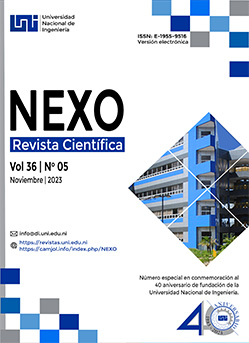Towards sustainable construction through timber and parametric design: applications and results
DOI:
https://doi.org/10.5377/nexo.v36i05.17282Keywords:
Climate change, sustainability, 2030 agenda, timber, parametric design, sustainable materia1Abstract
Cities and construction are currently catalysts for sustainable development since today close to 60% of the population lives in cities and it is expected that by 2040 the figure will increase to 75%; On the other hand, the construction sector is responsible for generating about 35% of CO2 emissions, which makes it one of the most polluting sectors. According to studies carried out by the U.N. Globally, cities occupy only 3% of the land, but represent close to 60% of the consumption of energy and natural resources. This implies that during the next decades construction will have to face many problems and will have to adapt to current adversities. Thus, technology, materials and innovation will be catalysts in order to try to mitigate the effects of climate change. This research was carried out with a perspective of different disciplines, such as: ecology, biology, engineering, architecture, this to obtain a better result and thus face climate change; It was thus that we concluded how the use of timber, parametric design and software can be an option to modify the practices of the construction sector and that they have a positive future in the future of architecture. Through the presentation of a light structure, the sustainable results presented by timber and parametric design will be analyzed.
Downloads
Downloads
Published
How to Cite
Issue
Section
License
Copyright (c) 2023 Array

This work is licensed under a Creative Commons Attribution 4.0 International License.
The authors who publish in Nexo Scientific Journal agree to the following terms:
- Authors retain the copyright and grant the journal the right of the first publication under the license Creative Commons Attribution License https://creativecommons.org/licenses/by/3.0/, which allows others to share the work with a recognition of the authorship of the work and the initial publication in Nexo Scientific Journal.
- Authors may separately establish additional agreements for the non-exclusive distribution of the version of the work published in the journal (for example, in an institutional repository or a book), with the recognition of the initial publication in Nexo Scientific Journal.
- Authors are allowed and encouraged to disseminate their works electronically (for example, in institutional repositories or in their own website) before and during the submission process, as it can lead to productive exchanges, as well as earlier and greater citation of published works.











